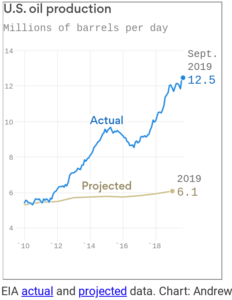🎄 Happy Christmas Eve eve!
- Today’s Smart Brevity™ count: 640 words … 2½ minutes.
1 big thing: The decade that blew up energy predictions

America’s energy sources, like booming oil and crumbling coal, have defied projections and historical precedents over the last decade, Axios’ Amy Harder and Andrew Witherspoon write for her year-end “Harder Line” column.
- Why it matters: Change can happen rapidly and unexpectedly, even in an industry known to move gradually and predictably.
With a new decade upon us, let’s look back at the last one’s biggest, most surprising energy changes.
- These five charts show U.S. Energy Information Administration projections from a decade ago, with current EIA data to show what actually happened.
⛽ 1.
🛢️ 2.
🔥 3.
⚡ 4.
🏭 5.
Steve Milloy: President Trump’s Energy Victory Lap on his ‘energy dominance’ policy
Deregulatory accomplishments spotlighted by the president included:
—Withdrawing the United States from the “fraudulent, ineffective and one-sided Paris climate accord.”
—Ending the Obama war on energy, especially policies designed to kill coal miner jobs including the Clean Power Plan, stream (over)-protection rule.
—Opening up federally owned lands and offshore areas to energy exploration and production, including the Arctic National Wildlife Refuge, which Republicans have been trying to open up since at least President Reagan’s administration.
—Greenlighting vital pipeline projects such as the Keystone XL and Dakota Access.
2018 Study: U.S. Leads World In Reducing CO2 Emissions, While UN Paris Accord Nations Break Promises – Moore notes that America was able to make this progress despite never signing the Kyoto Protocol, never enacting a carbon tax, refusing to impose a “cap and trade” carbon emission program, and “that environmental villain Donald Trump pull[ing] America out of the Paris climate accord.”
So America is doing pretty well on its own. But how’s Europe doing? Not great overall. BP’s study found that European Union emissions were up overall (1.5%), “with just Spain accounting for 44% of the increase in EU emissions.” The UK and Denmark, however, did report their lowest carbon emissions yet, though still not matching the U.S.







